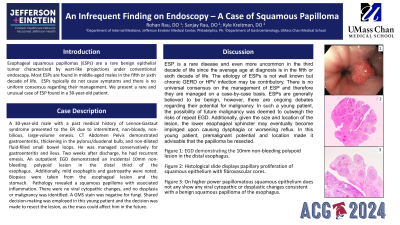Tuesday Poster Session
Category: Esophagus
P3952 - An Infrequent Finding on Endoscopy: A Case of Squamous Papilloma
Tuesday, October 29, 2024
10:30 AM - 4:00 PM ET
Location: Exhibit Hall E

Has Audio

Rohan Rau, DO
Albert Einstein Medical Center
Philadelphia, PA
Presenting Author(s)
Rohan Rau, DO1, Sanjay Rau, DO2, Kyle Kreitman, DO3
1Albert Einstein Medical Center, Philadelphia, PA; 2University of Massachusetts, Worcester, MA; 3UMass, Worcester, MA
Introduction: Esophageal squamous papillomas (ESPs) are a rare benign epithelial tumor characterized by wart-like projections under conventional endoscopy. Most ESPs are found in middle-aged males in the fifth or sixth decade of life. ESPs typically do not cause symptoms and there is no uniform consensus regarding their management. We present a rare and unusual case of ESP found in a 30-year-old patient.
Case Description/Methods: A 30 year old male with a past medical history of Lennox-Gastaut syndrome presented to the ER due to intermittent, non-bloody, non-bilious, large-volume emesis. CT Abdomen Pelvis demonstrated gastroenteritis, thickening in the pylorus/duodenal bulb, and non-dilated fluid-filled small bowel loops. He was managed conservatively for gastroenteritis and ileus. Two weeks after discharge, he had recurrent emesis. An outpatient EGD demonstrated an incidental 10mm non-bleeding polypoid lesion in the distal third of the esophagus. Additionally, mild esophagitis and gastropathy were noted. Biopsies were taken from the esophageal lesion and the stomach. Pathology revealed a squamous papilloma with associated inflammation. There were no viral cytopathic changes, and no dysplasia or malignancy was identified. A GMS stain was negative for fungi. Shared decision-making was employed in this young patient and the decision was made to resect the lesion, as a slowly growing mass could affect him in the future.
Discussion: ESPs are a rare disease and even more unusual in the third decade of life. The etiology of ESPs is not well known, but chronic GERD or HPV infection may be contributory. Management is controversial and decisions regarding resection are made on a case by case basis. ESPs are generally believed to be benign, however, there are ongoing debates regarding their potential for malignancy. In such a young patient, the possibility of future malignancy and development of dysphagia related symptoms are important considerations when deciding whether resection is appropriate. Endoscopists should be aware of these lesions and understand the potential risk of malignancy. It may be beneficial to consider resection in these patients to prevent further complications down the road. Additional studies will be needed to provide further guidance.

Disclosures:
Rohan Rau, DO1, Sanjay Rau, DO2, Kyle Kreitman, DO3. P3952 - An Infrequent Finding on Endoscopy: A Case of Squamous Papilloma, ACG 2024 Annual Scientific Meeting Abstracts. Philadelphia, PA: American College of Gastroenterology.
1Albert Einstein Medical Center, Philadelphia, PA; 2University of Massachusetts, Worcester, MA; 3UMass, Worcester, MA
Introduction: Esophageal squamous papillomas (ESPs) are a rare benign epithelial tumor characterized by wart-like projections under conventional endoscopy. Most ESPs are found in middle-aged males in the fifth or sixth decade of life. ESPs typically do not cause symptoms and there is no uniform consensus regarding their management. We present a rare and unusual case of ESP found in a 30-year-old patient.
Case Description/Methods: A 30 year old male with a past medical history of Lennox-Gastaut syndrome presented to the ER due to intermittent, non-bloody, non-bilious, large-volume emesis. CT Abdomen Pelvis demonstrated gastroenteritis, thickening in the pylorus/duodenal bulb, and non-dilated fluid-filled small bowel loops. He was managed conservatively for gastroenteritis and ileus. Two weeks after discharge, he had recurrent emesis. An outpatient EGD demonstrated an incidental 10mm non-bleeding polypoid lesion in the distal third of the esophagus. Additionally, mild esophagitis and gastropathy were noted. Biopsies were taken from the esophageal lesion and the stomach. Pathology revealed a squamous papilloma with associated inflammation. There were no viral cytopathic changes, and no dysplasia or malignancy was identified. A GMS stain was negative for fungi. Shared decision-making was employed in this young patient and the decision was made to resect the lesion, as a slowly growing mass could affect him in the future.
Discussion: ESPs are a rare disease and even more unusual in the third decade of life. The etiology of ESPs is not well known, but chronic GERD or HPV infection may be contributory. Management is controversial and decisions regarding resection are made on a case by case basis. ESPs are generally believed to be benign, however, there are ongoing debates regarding their potential for malignancy. In such a young patient, the possibility of future malignancy and development of dysphagia related symptoms are important considerations when deciding whether resection is appropriate. Endoscopists should be aware of these lesions and understand the potential risk of malignancy. It may be beneficial to consider resection in these patients to prevent further complications down the road. Additional studies will be needed to provide further guidance.

Figure: Figure 1. EGD demonstrating the 10mm non-bleeding polypoid lesion. Biopsies were obtained and confirmed a squamous papilloma.
Disclosures:
Rohan Rau indicated no relevant financial relationships.
Sanjay Rau indicated no relevant financial relationships.
Kyle Kreitman indicated no relevant financial relationships.
Rohan Rau, DO1, Sanjay Rau, DO2, Kyle Kreitman, DO3. P3952 - An Infrequent Finding on Endoscopy: A Case of Squamous Papilloma, ACG 2024 Annual Scientific Meeting Abstracts. Philadelphia, PA: American College of Gastroenterology.
